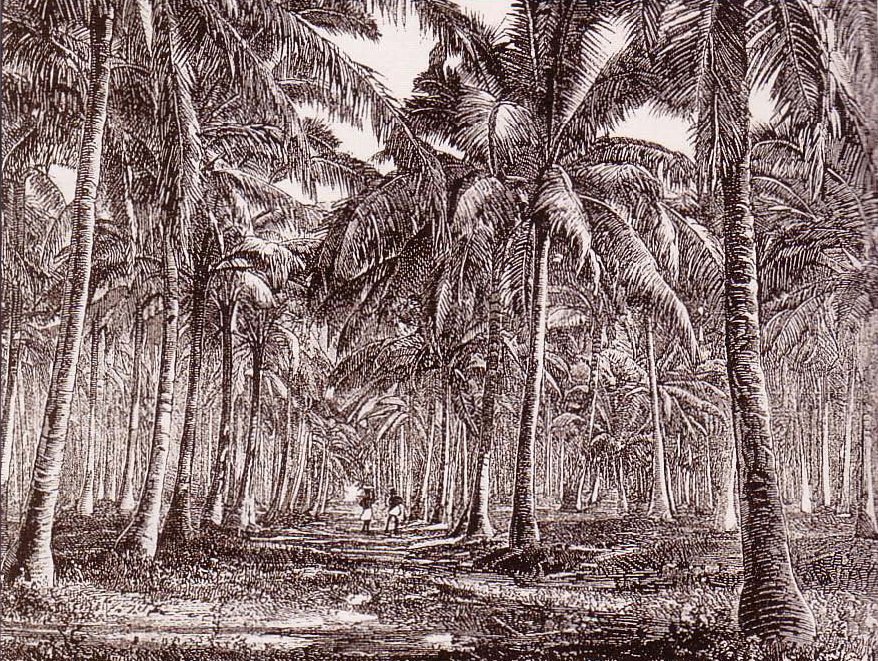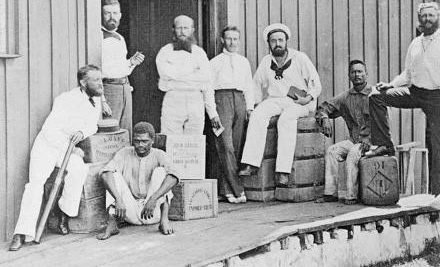Historical Context
The Godeffroys were French Huguenots (Protestants) of La Rochelle. In 1737 they were forced to flee France to avoid religious persecution after events following the Edict of Fontainbleau in 1685. The family sought asylum in Germany and settled in the trading port of Hamburg finally founding a trading empire known as J.C. Godeffroy & Sohn. The elder Godeffroy, a personal friend of Otto von Bismarck, was to enlist his sympathies. Within the succeeding five years they had establishments in Valparaiso, Cochin China, and in Sydney, Melbourne, and Adelaide. It was from Valparaiso that the first Trading agents, August Unslelm and Theodore Weber, came to Polynesia.

Their first enterprises to the South Seas were about the year 1845, in the Sandwich Islands. The first Hamburg merchant ship called at Apia, Samoa, (then known as the Navigator Islands) in 1847. Ten years later this port was chosen to be the centre for the trade of the ‘Godeffroy und Sohn’ firm .
Rules for traders:
In the choice of his traders he (Weber) took no account of nationality. For those seeking employment he had, it is said, but three questions, and all required affirmative answers: “Can you speak the language?” “Can you live among natives without quarrelling with them?” “Can you keep your mouth shut?”
Two points of advice were given:
“Have a woman of your own, no matter what island you take her from; for a trader without a wife is in eternal hot water;” and “Give no assistance to missionaries either by word or deed, beyond what is demanded of you by common humanity” – for the missionary taught the native that cloth or coin were better payment for produce than beads and tobacco”.
Pereira Timeline





1855 AD – August Unshelm and Theodor Weber arrive in Apia from Valparaiso, Chili, representing the great Hamburg House of Johann Cesar Godeffroy und Sohn. August Unshelm is man of great trading ability and tact, he commences trading in Matafele, Apia and in a few years he had instituted there a successful business in trade and oil.
1855 AD – Antonio Pereira Vitorino De Barros (aka Atone) also arrives in Apia. It is unclear as to who he has traveled with. Speculation that he has arrived with the Unshelm contingent is strong. He is reputed to have been born in Cape Verde, on the west coast of the African continent. Recruited by August Unshelm himself, he trades for ‘Godeffroy und Sohn’
1856 AD – Antonio’s brother Pedro (unconfirmed) and their sister Maria’s son Sese Perez (unconfirmed) arrive on the scene in Apia, most likely due to the prospects and success of their settled relative Antonio.
1861 AD – Sometime before 1861, August Unshelm is lost at sea due to a hurricane in the Fijian Archipelago. Theodor Weber, then a young man of twenty-seven, who had also come to Samoa from the German firm through its Valparaiso branch, takes charge of the Godeffroy und Sohn business.
1863 AD – Antonio Pereira travels to Fakaofo, Tokelau, on the ship ‘Augustita’, soon after the last of the slave ships had departed leaving 57 Tokelauans in Fakaofo. Although a Portugese subject, Antonio had sought and appropriated British protection.
1864 AD – Sese Perez (aka Hehe) arrives in Nukunonu, Tokelau. He is unable to acquire land rights for himself. Now also known as a Portugese trader for Godeffroy und Sohn in Samoa, Sese marries a Fakaofo woman (Loha) who has customary land rights.
1866 AD – A deal for the sale of the Islets of Fenuafala for $600 to Theodore Weber from Benjamin Hughes (Peni) in September takes place. Antonio is charged with the administration of the land which is assimilated into his personal portfolio.
1867 AD – At around this time, the seat of native government was transferred to Apia from Malie, the ancient home of the Malietoa family. Antonio Pereira was eventually to purchase a parcel of the Malie stronghold and parts of the Apia Port and coastal areas.
1870 AD – Travelling between Tokelau and Samoa, where Antonio also had interests, he finally leaves Fakaofo for Samoa. His son José is left in control of all property and business. José is now known simply as ‘Peleila’.
1874 AD – While living in Samoa, Antonio by now an esteemed trader, buys the Islets of Fenualoa and Nukumatua from two Fakaofo men, Hiva and Pou, registering the witnessed document with the British Consul in Apia. The sale was fraudulent from the outset, Antonio was well aware of previous arrangements, but maintained his claim. Antonio and Jose establish control over Fenualoa mainly by their aggressive occupation of the Islet. Stalwart Catholics with convert numbers in their favour, they are able to overwhelm the Protestant population of native tokelauan ‘aliki ma faipule’ by threat of arms.
1882 AD – Even under threat of the ‘Western Pacific High Commission’ and it’s plan of dispatching the ‘HMS Diamond’ “…to remove from the island those British subjects may be dangerous to peace and order…” Jose defiantly remained in effective control of Fenuafala and Fenualoa Islets of Fakaofo.
The distinguishing feature of the Godeffroy Company in the South Seas was the large scale of their activities. From Apia trading vessels radiated to the surrounding islets. The consular report of 1883 shows the preponderance of German trade and shipping over that of other countries. Shipping alone increased from eight vessels in 1859 to one hundred and sixty-one in 1883.
Tensions caused in part by the conflicting interests of the German traders, plantation owners, British business enterprises and American business interests, led to the first Samoan Civil War. The war was fought roughly between 1886 and 1894, primarily between Samoans though the German military intervened on several occasions. The United States and the United Kingdom opposed the German activity which led to a confrontation in Apia Harbor in 1887
Theodore Weber’s greatest work was his persistent acquisition, on behalf of the firm which he represented, of tracts of land which at the time of his surrendering the management at Apia in 1888 and his death the following year at Hamburg at the age of fifty-two, amounted to seventy-five thousand acres, much of it of the cream of Upolu and much of what constituted Samoa.
The Land Commission of 1891-1894 threw many land claims out and reduced most, but it found nearly all of Weber’s purchases valid and based upon good consideration. His system of imported controlled labour is the only one that has so far been found entirely satisfactory; his plantations alone offer no interference with the ordinary life of the Samoans.
1899 AD – As age and poor health begin to take its toll, José Pereira, weary of the internal divisions within the realms of Samoa and Tokelau, the ‘Western Pacific High Commission’ rulings and questions that may result, writes a letter to his sister Malia Ioane Pereira to outline his wishes and intentions for the affairs of the family legacy. It is apparent by the wording of this manuscript (ref: original document) that the Lands of Malie and Fatipule in Samoa are central to the inheritance. José is clear to maintain that the lands of Tokelau are to be communally toiled for the benefit of all, insisting that the Copra plantations and revenue derived to be worked and shared together.
After the Second Samoan Civil War, the Samoan Islands were divided by the three involved powers. The Samoa Tripartite Convention gave control of the islands west of 171 degrees west longitude to Germany, the eastern islands to the United States (present-day American Samoa) and the United Kingdom was compensated with other territories in the Pacific and West Africa
